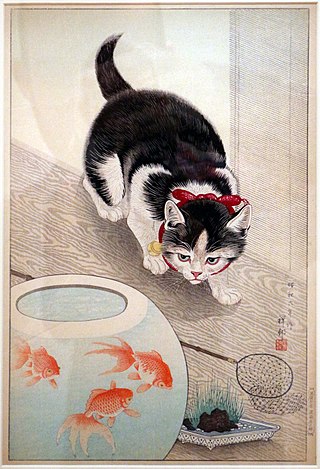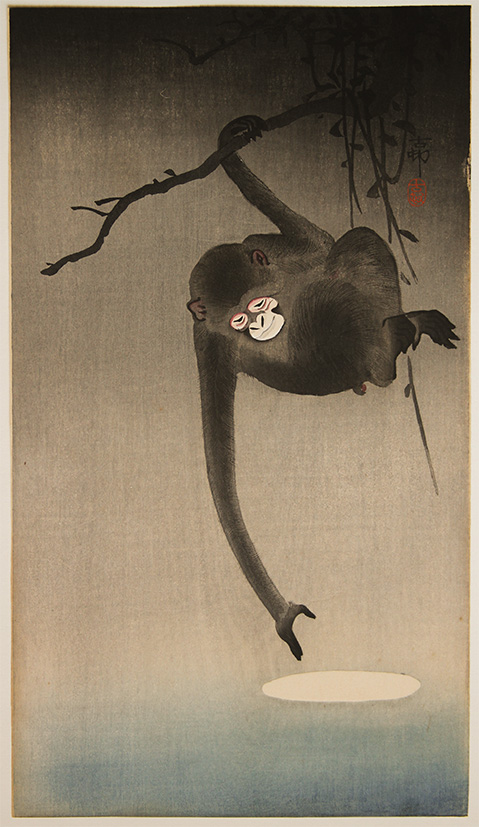
Cat and Bowl of Goldfish 
Monkey reaching for the moon 
Cockatoo on Pomegranate
Ohara Koson, a Japanese painter and woodblock print designer of the late 19th and early 20th centuries. Ohara Koson was famous as a master of (bird-and-flower) designs. Throughout a prolific career, in which he created hundreds of prints, he went by three different titles: Ohara Hōson, Ohara Shōson and Ohara Koson. He was born Ohara Matao; it is thought that he started training in painting and design at the Ishikawa Technical School in 1889–1893. He also studied painting with Suzuki Kason (1860–1919), although accounts differ on whether this happened during his school years or after he moved to Tokyo in the middle to late 1890s. In Tokyo, he produced some ukiyo-e illustrating episodes of the Russian/Japanese War but most of his production was prints of birds-and-flowers. He worked at first with publishers Akiyama Buemon (Kokkeidō) and Matsuki Heikichi (Daikokuya), signing his work Koson. Starting around 1926, he became associated with the publisher Watanabe Shozura, and signed his work Shōson. He also worked with the publisher Kawaguchi, signing his works Hōson. Through his association with Watanabe, Ohara’s work was exhibited abroad, and his prints sold well, particularly in the United States. He was active designing prints until at least 1935, and died at his home in Tokyo in 1945. His work is held in several museums worldwide, including the Toledo Museum of Art, the Brooklyn Museum, the British Museum and the Museum of Fine Arts, Boston. The first image chosen to explore is called Monkey reaching for the moon. The image and the story behind the image is as such; a Buddhist story in which a monkey attempts to seize the reflection of a moon in a well; it fails when the branch from which it is hanging from breaks. The monkey stands for unenlightened people who cannot distinguish between reality and illusion. Also there is additional information that can be inferred through the image such as reflection and the use of light/dark in the art. The only two allusions and thus reflections found in the image are the monkeys face and the reflection of the moon, both white in contrast with the grays, browns and blacks of the surrounding area. In addition the image is unique and interesting to study/dissect because of the small finite details put into the monkeys fur and facial features. Contrast also plays a role in Cockatoo on Pomegranate as well. In Cockatoo on Pomegranate, a lifelike impression painted on a color woodblock print. The painting is immediately striking due to the color selection by the artist. A white bird placed against a black backdrop with the only other colors being the slightly less noticeable browns and greens of the tree and the vibrant red of the pomegranate fruit. In Cat and Bowl of Goldfish the color choice is unique and striking as well. The background is lighter whites/cream white/brown and highlights the black fur of the cat along with the oranges of the goldfish. What Koson does in all these depictions of animals is he chooses colors that highlight them instead of placing them in backgrounds that take away from them. The pomegranate and goldfish both hold buddhist meanings/ties as the goldfish represents freedom (goldfish can swim anywhere they want in water) and the pomegranate is one of the three sacred fruits along with lemons and peaches.
Sources/Sites:
https://en.wikipedia.org/wiki/Ohara_Koson
https://www.wikiart.org/en/ohara-koson
https://www.artelino.com/articles/koson_ohara.asp
http://www.myjapanesehanga.com/home/artists/ohara-koson-1877—1945-
https://woodblock-print.eu/japanese-artists/ohara-koson-1877-1945.html